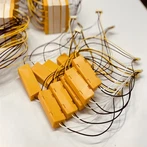Sucker rods are vital components in oil well pump systems designed to operate the downhole piston and extract crude oil from reservoirs. They are produced from various materials including steel, fiberglass, aluminum alloys, and carbon composites. Our blog elucidates the composition, properties, advantages, and limitations to inform optimal material selection.
1. Is Steel Sucker Rod Good?
Steel rods have traditionally been the dominant material choice owing to their exceptional tensile strength, durability, and cost-effectiveness. They are typically manufactured from high-grade medium carbon steel like AISI 1045 with around 0.45% carbon content. The steel may be heat treated by quenching and tempering to achieve tensile strengths over 100 ksi.
The excellent strength enables steel rods to withstand heavy dynamic and static loads during reciprocating motion. The moderate carbon content provides reasonable ductility, fatigue resistance, and machinability relative to higher alloy steels. Additional alloying elements like chromium, vanadium, and molybdenum are often incorporated to enhance hardness, fatigue life, and corrosion resistance.
(1)Installation and Maintenance
Proper installation is key to preventing premature steel rod failures. API guidelines recommend limiting initial curved deformations to 0.2 In./ft and stored curvatures below 0.1 In./ft. Gradual straightening is preferred over abrupt bending adjustments. Adequate thread lubrication should be applied to avoid galling during makeup (API 11B, 2015).
Regular lubrication, visual inspection, and periodic NDT testing are imperative to combat rod wear, corrosion, and cumulative fatigue damage (Jennings et al., 1993). Rod ends may be cropped to eliminate damaged sections. Worn rods should be replaced promptly to avoid well productivity declines.
2. Fiberglass Sucker Rods: Strength, Weight, and Corrosion Resistance Properties
Fiberglass rods exhibit higher tensile strength exceeding 160 ksi coupled with substantially lower weight, enhancing lifting capacity and efficiency in deeper wells (Jennings et al., 1993). They are produced via pultrusion of thermoset polyester or vinylester resin reinforced by wrapped strands of high-strength glass fibers.
The high fiber volume fraction of up to 80% imparts outstanding specific strength and stiffness. Fiberglass demonstrates superior fatigue resistance with less sensitivity to accumulated damage (Jennings et al., 1993). The rods are also naturally corrosion-resistant without requiring protective coatings.
(1)How much does an 1.25 fiberglass sucker rod weigh?
Its weight can vary depending on the manufacturer and the exact specifications. However, fiberglass rods are generally lighter than steel rods. To give a rough estimate, a typical 1-inch fiberglass rod usually weighs around 1.5 to 2 pounds per foot.
Aluminum Alloy Sucker Rods – Lightweight yet Compliant Alternative
Aluminum alloy proffers around 40% weight savings relative to steel, reducing load stresses on tubing. High-strength aluminum alloys like 6061 and 7075 containing magnesium and zinc are typically utilized. Aluminum exhibits excellent corrosion resistance.
However, aluminum rods are more compliant than steel, exhibiting greater elastic deflections and propensity for buckling (Postler, 1997). Fatigue strength is also inferior to steel. Thus aluminum rods are generally limited to less deviated, low-load wells. Proper coupling with steel pony rods is crucial to mitigate coupling wear from flexural stresses.
Are you in search of a reliable partner to supply high-quality Sucker Rods? Vigor can provide you with procurement services. Our materials are AISI A-4130-M, A-4140-M, A-4142-M, A-4330-M, and A-4138-M, which conform to API Specification 11B. We provide mechanical property data for commonly used materials. For special requests, please contact us for verification. please contact us at info@vigorpetroleum.com.





